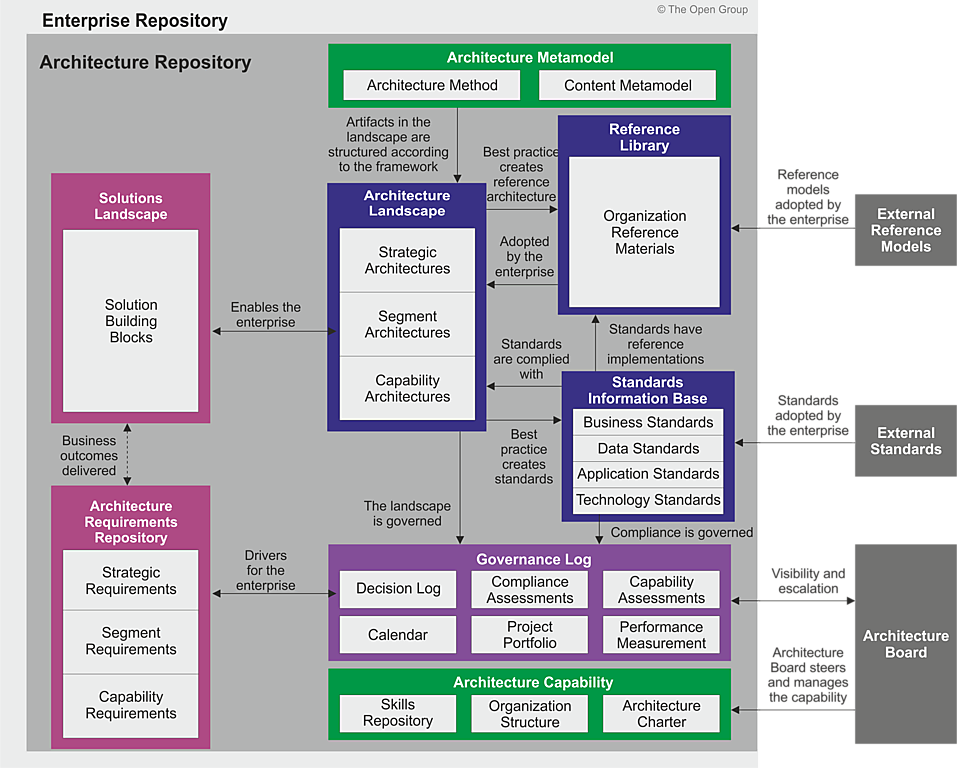Understanding the TOGAF Architecture Repository: A Vital Component for Enterprise Architecture
In the realm of Enterprise Architecture (EA), effective management of architectural assets is crucial for success. The TOGAF Architecture Repository serves as a comprehensive content management system that provides a structured approach to storing, managing, and accessing all architecture-related projects within an organization. This article explores the key components of the Architecture Repository, its benefits, and its role in facilitating efficient architecture development and governance.
What is the Architecture Repository?
The Architecture Repository is a centralized hub that enables organizations to manage their architectural deliverables, locate reusable assets, and publish outputs to stakeholders and other interested parties. By providing a structured environment for architecture-related content, the repository enhances collaboration, promotes standardization, and supports the overall effectiveness of the architecture practice.

Key Components of the Architecture Repository
The Architecture Repository typically includes the following contents:
-
Architecture Framework
- This section outlines the overarching architecture framework adopted by the organization, detailing the methodologies, processes, and tools used in architectural development. It serves as a guiding document for all architecture-related activities, ensuring consistency and alignment with organizational goals.
-
Standards Information Base
- This component contains information about standards, guidelines, and best practices that govern architectural activities. It includes industry standards, internal policies, and compliance requirements that architects must adhere to during the design and implementation phases.
-
Architecture Landscape
- The Architecture Landscape provides a visual representation of the organization’s current architecture, including its components, relationships, and dependencies. This overview helps stakeholders understand the existing architecture and identify areas for improvement or transformation.
-
Reference Architectures
- Reference architectures are pre-defined templates or models that illustrate best practices for specific domains or solutions. They serve as a starting point for architects, allowing them to leverage proven designs and accelerate the development of new projects.
-
Governance Log
- The Governance Log tracks decisions, approvals, and actions taken throughout the architecture development process. It ensures accountability and transparency by documenting the governance activities that influence architectural decisions and outcomes.
Initial Repository Content in the Preliminary Phase
During the Preliminary Phase of the TOGAF ADM (Architecture Development Method), the initial content of the Architecture Repository is established. This phase lays the groundwork for the architecture practice by defining the goals, principles, and scope of the architecture framework.
Steps to Establish the Initial Repository Content
- Define the Architecture Framework: Establish the guiding principles and methodologies that will govern architectural activities within the organization.
- Identify Standards and Guidelines: Compile relevant standards and guidelines to create a Standards Information Base that supports compliance and best practices.
- Develop the Architecture Landscape: Create an initial representation of the current architecture to provide a baseline for future development.
- Document Reference Architectures: Collect and document existing reference architectures that can be used as templates for future projects.
- Establish Governance Processes: Set up governance processes and create the Governance Log to track decisions and approvals.
Benefits of the Architecture Repository
The Architecture Repository offers several benefits to organizations implementing TOGAF:
- Centralized Access: A single repository for all architecture-related content ensures that stakeholders can easily access and share information.
- Improved Collaboration: By providing a structured environment for managing architectural assets, the repository fosters collaboration among architects, project managers, and business stakeholders.
- Enhanced Reusability: The repository encourages the reuse of architectural assets, reducing redundancy and accelerating project delivery.
- Streamlined Governance: The Governance Log and defined standards promote accountability and compliance, ensuring that architectural decisions align with organizational objectives.
Conclusion
The TOGAF Architecture Repository is a critical component of effective Enterprise Architecture management. By serving as a centralized content management system for architecture-related projects, it facilitates the organization, accessibility, and governance of architectural assets. Establishing a well-structured Architecture Repository not only enhances collaboration and standardization but also supports the overall success of architectural initiatives within the enterprise. As organizations continue to navigate the complexities of modern business environments, leveraging the Architecture Repository will be essential for achieving strategic goals and driving innovation.
The successful implementation of the TOGAF Architecture Repository at InnovateTech Solutions transformed the organization’s approach to architecture management. By centralizing architectural assets, enhancing collaboration, promoting reusability, and establishing robust governance, InnovateTech was able to streamline its architecture practices and improve project outcomes. This case study demonstrates the value of the TOGAF Architecture Repository as a critical component of effective Enterprise Architecture management, enabling organizations to navigate the complexities of modern business environments with greater agility and efficiency.

